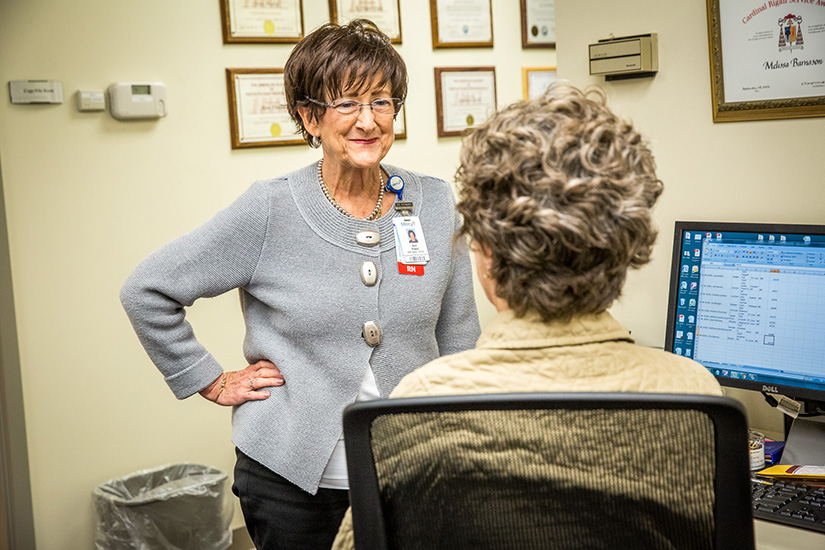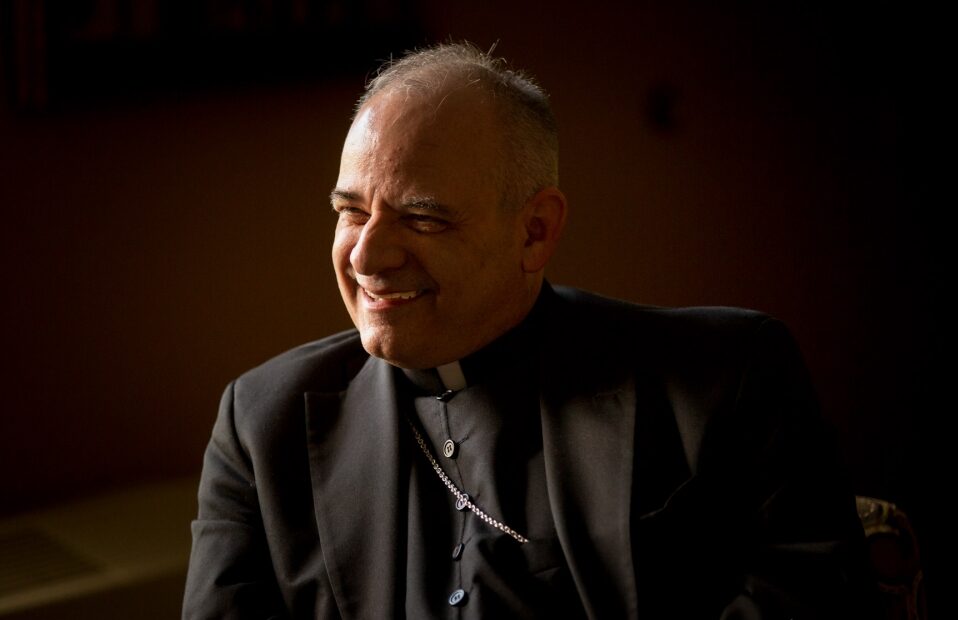Dignity of a ‘happy death’

Catholic health care and hospice address the spiritual dimension of dying
For the past several weeks, Jeanette Hilkenkamp’s three daughters have kept vigil at her bedside.
It’s been somewhat of a welcome change of pace for the 85-year-old, who in the past four months has been through a whirlwind of movement from home to hospital to assisted living. Several weeks ago, her daughters made the difficult decision to bring their mother to the deGreeff Hospice House at St. Anthony’s Medical Center.
Navigating their mother’s health care, especially in the past several months, has not been without challenges, said daughter Bobbie Wieman. But making the decision to do hospice has given them an opportunity to think more deeply about Jeanette’s end-of-life care. The pace is slower, and the decisions about when to eat and what types of medications to take have a more relaxed approach.
“This place is so cool, because there’s dignity here,” said Bobbie Wieman.
Born and raised Catholic, and a longtime member of St. Simon Parish, Jeanette has often prayed for a peaceful death, when the time comes. “Spiritually, she’s ready,” Bobbie said. “We’ve told her that it’s OK — don’t worry about us, that we would be OK.”
End-of-life issues eventually touch all of us. Advances in medical technology have altered our understanding of dying. The old Christian tradition of dying a “happy death” has been replaced with smarter technology that promises an extension of life. As a result, we have lost some important spiritual values, said Dominican Father Charles Bouchard, senior director of theology and ethics with the Catholic Health Association of the United States.
Approximately 90 percent of people prefer to die at home, according to a Gallup Poll via the Dartmouth Atlas of Health Care. Yet most patients do not die at home, and their care is often not aligned with their preferences, said Father Bouchard, one of several presenters at an Oct. 20 conference on end-of-life issues, sponsored by the Institute for Theological Encounter with Science and Technology (ITEST) at St. Louis University.
“This whole area of heath care is changing very rapidly for a lot of reasons,” including technological, political and economical changes, he noted. “We provide people with a lot of (health) care that they don’t need.”

The “happy death” is a long-held “tradition and way of understanding of death that we have lost,” he said. “And Catholic health care should try to recover that … the happy death for us has a clear and distinct spiritual dimension to it.”
Several factors make dying and death a problem today, Father Bouchard said. In the 1900s, the average life expectancy was about 50 years old. Today, it’s about 78. A century ago, we focused on providing comfort care at the end of a person’s life, and few people knew in advance that they were going to die from an illness. The majority of those diagnosed with an illness today have a greater understanding of the course of the disease and the options to prolong life.
Additionally, the mentality toward patient autonomy has changed. What used to be viewed as “doctor knows best” has been replaced with the idea of the physician as the agent of the patient. “We need to find middle ground that puts patient care first,” he said, including looking at health care as a collaborative effort between the physician, patient and allied health care professionals.
Managing illness and death — which has an objective, scientific element — requires moral certitude as we balance the benefits versus the burdens of our health care decisions. While we might never have an absolute, objective certainty, moral certitude is what helps us propel forward, Father Bouchard said.
“For us as Christians, we have to rely on the gifts of the Holy Spirit to help us get to this point,” he said. “There’s a lot of clinical information that goes into it, but there’s also prayer and relying on the gift of prudence perhaps, which enables us to take all this information in with confidence in God and then come to a decision that we feel is God’s will for us. It’s really a gift of the Spirit to be able to do that.”
Beryl Schmittgens relied on her faith when it came to making end-of-life decisions for her husband, Norb, who died Oct. 12 at deGreeff Hospice House at the age of 87. She prayed he would have a peaceful death, and to her relief, that’s what happened.
“I knew all along that this was where I was hoping he would go,” said Beryl, who previously volunteered there before her husband became ill. “It was like a home, a comfortable setting.” Neither one of them wanted any extraordinary measures that would unnecessarily prolong their lives.
Bob Eigenrauch, chaplain at deGreeff Hospice House, noted that hospice and palliative care, while different in their approaches, provide an opportunity for individuals to refocus on the spiritual element of dying.
“Many times, patients are peripherally connected to their faith, but are feeling guilty, that they’re not going in the right direction,” he said. “We help make God and the Church relevant again and remind them of God’s unconditional love. We have to time to establish a rapport and get people to share the stories of their lives. Doctors don’t always have that time, but I do” as a chaplain.
Dying with dignity means to have a death that’s happened peacefully, Father Bouchard said. “With hope in God, hope of the Resurrection, belief of God’s grace in your life and gratitude above all. We can look back at our lives and say I’m so grateful to God for everything that I’ve received.”
Palliative care preferences for alleviating pain, suffering

As a result of advances in public health and the development of lifesaving medical technology, Americans live longer than ever. Death, when it comes, often follows a chronic or progressive illness.
Unfortunately, the care received near the end of life often does not reflect a person’s values, goals and informed preferences. Although the majority of people say they would prefer to die at home, two-thirds of Medicare beneficiaries die elsewhere, such as a hospital’s intensive care unit. People frequently endure unwanted treatment and suffer from inadequate pain management and shortness of breath, which often puts an enormous stress on family caregivers. A fragmented medical system and a lack of communication among doctors, patients and families may result in less than optimal patient experience.
— The Pew Charitable Trusts May 11, 2015, fact sheet, “Improving End-of-Life Care”
Pew’s research shows that 78 percent of people don’t understand the purpose of palliative care. Even medical professionals are unaware of it.
Palliative care is supportive care for anyone with a serious, perhaps life-limiting illness. The field was developed in the late 1990s and recognized as a specialty.
Many consider its focus to be end-of-life care, but “the motto should be living well with serious illness,” Dr. Robert Bergamini said at a workshop Oct. 16 at the Annual Respect Life Convention in St. Charles.
Bergamini has spent most of his 35-year career as a pediatric hematologist-oncologist. He’s now also Mercy’s ministry-level medical director for palliative care, serving 39 hospitals and outpatient facilities and clinics in four states. He has been active with the Supportive Care Coalition.
Palliative care is compatible with curative treatments, such as an oncology rehab program to minimize side effects and relieve suffering. It also facilitates transition to hospice care. Patients have a team with a physician, nurse practitioner, social worker and chaplain.
Ann Prebil was diagnosed with ovarian cancer in January of 2009 and started the first of six rounds of chemotherapy the next month. She was introduced to Mercy palliative care and found it “an amazing resource,” part of her treatment “not for dying but for living, surviving and recovering,” she said.
The faith aspect is important as well, she said: “I believe that when you’ve got cancer, which of course I have it, faith is a very big part. I love it when people say ‘I’m praying for you’ because that’s the difference. That has made my journey from 2009 to today possible.”
She keeps doing treatments, she said, to stay alive and be as healthy as she can, and she offers up the side effects as a prayer for people in need. Palliative care brings a team to support her “and I don’t go through this alone,” said Prebil, a member of Our Lady of Lourdes Parish in University City.
Palliative care isn’t intuitive to most physicians, Bergamini said, noting that his medical school training on symptom control was limited to two days.
The Institute of Medicine report on “Dying in America,” shows that most people nearing the end of life aren’t physically, mentally or cognitively able to make their own decisions about care. The majority of these patients will receive acute hospital care from physicians who don’t know them. Therefore, advance care planning is essential to ensure that patients receive care reflecting their values, goals, and preferences.
Of people who indicate end-of-life care preferences, most choose care focused on alleviating pain and suffering. However, because the default mode of hospital treatment is acute care, advance planning and medical orders are needed to ensure that these preferences are honored.
Bergamini recommends family meetings that allow everyone to understand treatment plans and express concerns. Patients need to prepare their family members to be survivors, he added.
An advance directive, he said, is a gift to family members because it “speaks for you when you are unable to express your wishes. It only takes effect when you are unable to make your own decisions.”
Palliative care, Bergamini said, “makes the aid in dying (movement) irrelevant, because it won’t ever enter into the equation. Anyone who has a chronic illness should eventually seek palliative care to see what the options are.”
— Joseph Kenny
>> Mercy
Mercy Palliative Care offers supportive care that eases pain and stress for people with serious illnesses. It combines traditional medical therapies with treatment for emotional, social and spiritual needs. The palliative care team improves the quality of life for patients and their families.
Palliative care provides:
• Pain management and treatment for a variety of symptoms (for example fatigue, shortness of breath)
• Spiritual care that respects your cultural beliefs
• Ongoing communication and care coordination
• Help reviewing your goals for care, including advance planning when appropriate
• Emotional support
>> SSM
SSM Health at Home’s palliative care services improve a patient’s quality of life by helping relieve the pain and symptoms caused by serious or chronic illness, such as cancer, cardiac disease, respiratory disease, chronic obstructive pulmonary disorder (COPD), kidney failure, Alzheimer’s and other types of dementia, Parkinson’s disease, and stroke and other neurological diseases.
Among the symptoms SSM Health at Home helps with are pain, shortness of breath, fatigue, constipation, nausea, loss of appetite, difficulty sleeping and depression.
Palliative care can be provided at any stage of a serious or chronic illness, including at the same time as curative and life-prolonging treatments.
With palliative care, patients and families also have an advocate for navigating the health-care system. The benefit is improved pain and symptom management and a better understanding of the treatment plan.
SSM’s palliative care team works with the physician, who remains responsible for coordinating and managing overall medical care.
For the past several weeks, Jeanette Hilkenkamp’s three daughters have kept vigil at her bedside. It’s been somewhat of a welcome change of pace for the 85-year-old, who in the … Dignity of a ‘happy death’
Subscribe to Read All St. Louis Review Stories
All readers receive 5 stories to read free per month. After that, readers will need to be logged in.
If you are currently receive the St. Louis Review at your home or office, please send your name and address (and subscriber id if you know it) to subscriptions@stlouisreview.com to get your login information.
If you are not currently a subscriber to the St. Louis Review, please contact subscriptions@stlouisreview.com for information on how to subscribe.






